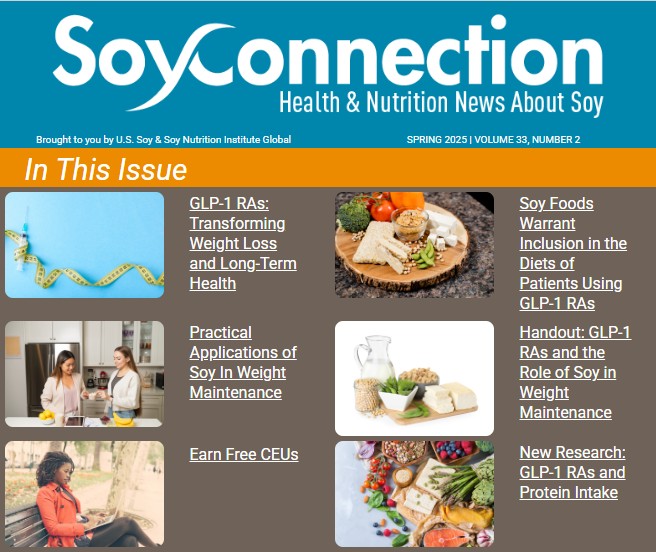More U.S. Health Professionals Recognize Soy As a Nutritious Choice
The top five takeaways from Soy Connection’s annual survey reveal encouraging trends in how health professionals view soy.

1. Soy Ratings Rebound: 73% of health professionals rate soy as a healthy, nutritious choice for themselves, and 75% say the same for clients – reflecting increases of 5% and 3% over 2024.
2. Trusted Protein Source: Consistent with previous years, health professionals agree soy is a nutritious, high-quality protein and safe and nutritious for women (79%), men (78%), and children (74%)—a confidence level that continues to trend upward.
3. Cooking Oils and Fats Rankings: Health professionals consistently rate soybean oil as a middle-tier choice (34%) among cooking oils and fats, ranking significantly higher than ghee (23%), butter (16%), and tallow (14%).
4. Processing Perceptions: Consistent with 2024 findings, health professionals remain cautious about processed foods (87%) and ultra-processed foods (95%) overall. However, soy yogurt, soymilk, and tofu are increasingly seen as less processed, while soy-based meat alternatives and soy burgers are perceived as more processed.
5. Recommendations in Practice: Among consulting health professionals, nearly one-third recommend soy foods and beverages often, and half report being approached by patients with soy-related concerns such as breast cancer, hormonal effects in males, genetic modification of soy, and allergies (trending down with a 6% decrease over 2024).

Science-Based Resources to Support Client and Patient Learning
Soy and breast cancer riskDespite concerns about soy and breast cancer risk and recurrence, clinical studies have shown that neither soy nor isoflavones negatively affect markers of breast cancer risk and breast cancer patients can safely consume soy foods.1 Consuming approximately two servings of soy foods daily during childhood and adolescence, such as a cup of soymilk or tofu, may reduce breast cancer risk later in life.2 Some population studies show that consuming soy after a breast cancer diagnosis may reduce breast cancer recurrence and breast cancer-specific mortality.3
Processed/ultra-processed foods
Scientists argue that many definitions of ultra-processed foods lack nuance, and that the nutritional contribution of a food should be primarily determined by its nutrient content, not solely by the degree of processing. For instance, the Nova food classification system’s definition of ultra-processed foods ranks cow’s milk as “minimally processed” while soymilk is classified as “ultra-processed”—the same category as packaged cookies and chips. Recent studies show that some categories of ultra-processed foods are not associated with an increased risk of chronic disease or are associated with decreased risk.4,5
Soy’s effect on male hormones
Extensive clinical trial data show neither soy nor isoflavones effect male hormones, fertility, or lead to gynecomastia.1
Soy allergies
Though soy is listed as one of the major food allergens, studies show that soy allergies are less common than other major food allergens like milk, eggs, fish, peanuts, and wheat. Only about three out of every 1,000 adults is allergic to soy, and there is a relatively low potency of soy protein for triggering an allergic response, especially a severe one.1
Genetic modification of soy
According to the American Association for the Advancement of Science, genetically modified crops are “the most extensively tested crops ever added to our food supply.” The U.S. Food & Drug Administration (FDA) ensures that genetically modified crops are safe by making sure that all foods that are genetically modified or contain genetically modified ingredients meet the same stringent safety standards as all other foods.6

Additional Survey Findings and Insights
1. Allergen Context: Compared to the other “Big 9” allergens including peanuts, milk, wheat, and sesame, soy ranks as a low to moderate concern among health professionals.2. Health Claim Awareness: Awareness of the FDA authorized health claim for soy protein continues to rise (54% in 2025 vs. 49% in 2023), while awareness of the FDA qualified health claim for soybean oil remains steady (23%).
3. Growing awareness of soy’s health benefits: Health professionals are increasingly recognizing soy’s role in multiple areas of wellness. Awareness of benefits for cognitive function and brain health rose to 64% (up from 61% in 2024), bone health reached 58% (up from 56%), and skin health climbed to 39% (up from 33%).
4. Awareness of soybean oil’s heart health benefits also grew: Increasing to 56% from 51% last year.

The Soy Connection Experience
• Soy Connection Newsletter Readership Growth: The newsletter now reaches one-third of health professionals, with frequency of reading on the rise.• Content Sharing: Information sharing with clients/patients increased by 7% over 2024. More readers are also sharing content with colleagues, amplifying the reach of evidence-based soy information.
• Continuing Education (CE) Awareness: Three in four eligible professionals are aware of Soy Connection’s CE opportunities.
• Perception of Value: Respondents continue to rate Soy Connection highly, citing timely, science-based information as its most valuable feature.
• Topics of Interest:
• Heart health and cognitive function remain top priorities.
• Growing interest in diabetes, processed/ultra-processed foods, and GLP-1 receptor agonists indicates evolving patient needs and professional focus areas.

Preferred Sources and Social Channels
• Top Resources: Professional associations and peer-reviewed journals remain the primary sources for nutrition updates.• Social Media Use: More than 25% of respondents do not use social media professionally. Among those who do, the leading platforms are Facebook, LinkedIn, and Instagram, followed by YouTube.
Survey Methodology
Every year, the United Soybean Board partners with Southpaw Insights to better understand how health professionals perceive soy and how Soy Connection can continue to deliver the most relevant and useful evidence-based information. This year’s survey, conducted between May 5 and July 9, 2025, provides a snapshot of health professionals’ evolving attitudes, information needs, and communication behaviors.Who Responded?
The 2025 survey garnered responses from 643 health professionals, representing a range of disciplines:• Registered Dietitian Nutritionists (RDNs): 56%
• Nurse Practitioners (NPs): 13%
• Physician Associates (PAs): 10%
• Nutrition and Dietetic Technicians: 4%
• Professors/Teachers: 3%
• Researchers: 2%
• Certified Dietary Managers/Food Protection Professionals: 1%
• Retired/Not Working: 8%
• Other (including registered nurses, administrators, food service directors, nutritionists, and social workers): 8%
Notably, there was a 4% increase in NP respondents and a 1% increase in PAs compared to 2024, reflecting growing engagement from advanced practice providers. This shift corresponds with a higher percentage of respondents who work directly with clients (85%), consistent with 2024 and significantly higher than 2023 (76%). These professionals influence daily nutrition decisions, making their input critical to our mission.
What’s Next?
These findings highlight opportunities to deliver even greater value through Soy Connection. In the coming months, qualitative research will explore these results in more depth, uncovering the “why” behind the numbers and guiding health professional communications.Our mission remains clear: to provide health professionals with the evidence-based information they need to confidently discuss soy with patients and clients. Whether it’s addressing concerns about breast cancer risk, examining the data around processing, or providing the latest insights on heart and cognitive health, Soy Connection is committed to supporting informed conversations and how diet can support positive health outcomes.
About Soy Connection
Soy Connection provides evidence-based information and resources about soy protein, oil and isoflavones, as well as a newsletter and free continuing education credits to registered dietitians and dietetic technicians, certified dietary managers, and certified food protection professionals.REFERENCES
1. https://sniglobal.org/wp content/uploads/2023/10/102023_HealthProGuide_Booklet_Final.pdf.
2. Baglia M.L., Zheng W., Li H., Yang G., Gao J., Gao Y.T., Shu X.O. The association of soy food consumption with the risk of subtype of breast cancers defined by hormone receptor and HER2 status. Int. J. Cancer. 2016;139:742–748. doi: 10.1002/ijc.30117. https://pubmed.ncbi.nlm.nih.gov/27038352/.
3. Messina Mark, Duncan Alison, Messina Virginia, Lynch Heidi, Kiel Jessica, Erdman John W., The health effects of soy: A reference guide for health professionals, Frontiers in Nutrition, 11 August 2022; https://doi.org/10.3389/fnut.2022.970364.
4. Examining the Nova Food Classification System and the Healthfulness of Ultra-Processed Foods. Academy of Nutrition and Dietetics. https://www.eatrightpro.org/news-center/practice-trends/examining-the-nova-food-classification-system-and-healthfulness-of-ultra-processed-foods
5. Chen Z, Khandpur N, Desjardins C, Wang L, Monteiro CA, Rossato SL, Fung TT, Manson JE, Willett WC, Rimm EB, Hu FB, Sun Q, Drouin-Chartier JP. Ultra-Processed Food Consumption and Risk of Type 2 Diabetes: Three Large Prospective U.S. Cohort Studies. Diabetes Care. 2023 Jul 1;46(7):1335-1344. doi: 10.2337/dc22-1993. PMID: 36854188; PMCID: PMC10300524. https://pmc.ncbi.nlm.nih.gov/articles/PMC10300524/.
6. https://www.fda.gov/media/135278/download.